From the archive
Click on the images to enlarge them.
Around the world: from 80 days to 4 hours and 55 minutes
Since Verne wrote Around the World in 80 days as a challenge (bet) in 1873, it became very popular to travel around the world in record time. The archives of the Dutch Jules Verne Genootschap hold a great number of articles and other objects related to this theme, of which the following reveals a glimpse.
Reporter Nellie Bly improved Verne’s fictitious 80 day record in January 1890. On her trip around the world in 72 days, 6 hours, 11 minutes and 14 seconds, she visited not only England, Japan, China, Hong Kong, but also the home of Jules Verne, Brindisi, Colombo, and San Francisco. She was also the first woman to travel around the world unaccompanied at all times by a man, and became a role model for women everywhere. Source: Wikipedia on Nellie Bly.
Her record was broken later that same year by the colourful shipping magnate George Francis Train, while Verne’s book saw its 8th edition in The Netherlands. Train’s first trip around the world in 1870 was likely the inspiration for Jules Verne’s Around the World in Eighty Days. The new record became 67 days, 12 hours and 3 minutes. Source: Wikipedia on George Francis Train.
The gradual improvement of infrastructure around the world enabled the establishment of a whole series of new records. These developments inspired Dutch author Jan Feith to publish his book Around the world in 40 days in 1908. This new target was reached by Mears in 1913, using trains and steamships.
In The Netherlands, in June 1912 the newspaper De Groene Amsterdammer questioned the usefulness of races around the world, and wondered how much money Phileas Fogg would have saved had he traveled 40 years later.
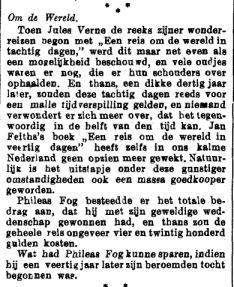
The movie Around the world in 18 days was produced in 1923, starring William Desmond. Its various parts were shown during three consecutive weeks in Cinema Olympia in The Hague in November 1923. A review in Het Vaderland dated October 10th mentions that airplanes were used in this film to reach the target.

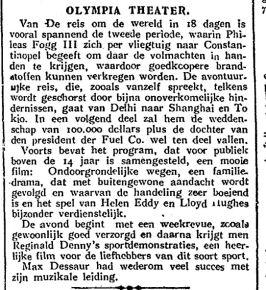
The same film was shown in Cinema Hollandia in Amsterdam in February 1924. This cinema did not advertise in the newspapers, but printed its publicity texts for this film on German banknotes, which had become worthless because of the hyperinflation in Germany in 1923-1924. After World War I Germany could not meet the demands for the repair payments imposed by the Versailles treaty and opted for the creation of new money by simply printing new bills. The highest denomination banknote had a value of 50,000 marks in 1922. In 1924 this was 100 billion (hundred thousand milliard) marks.
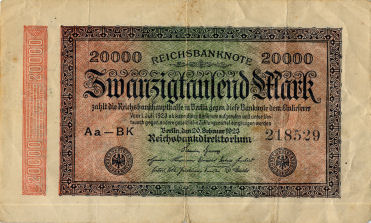
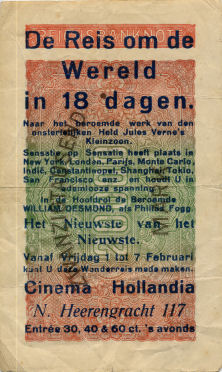
The first circling of the globe by airplane took place in 1924. Many intermediate stops were neede, and the actual time traveled was 371 hours and 11 minutes. A similar expedition, planning to do this in 300 hours crashed in Russia, after it had been announced as follows in the Dutch press:
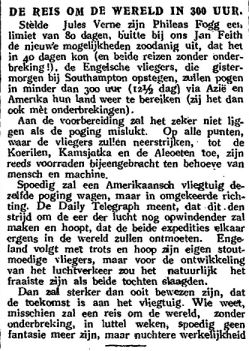
In 1926, another Dutch newspaper expresses skepticism about such superficial travel, in an article about two Americans planning to circle the globe in exactly 25 days:
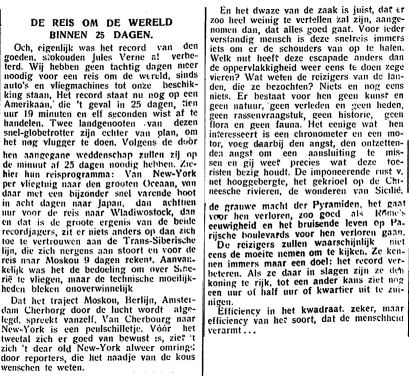
The commemoration of Jules Verne’s 100th birthday in 1928 triggered an epidemic of trips around the world. I refer to the Danish boy scout Palle Huld, who wrote a well-known book about his travel. He is considered by some to be the last overtly Vernian circumnavigator whose goal was competition with, rather than commemoration of Fogg’s fictional record. In that same year the Americans Mears and Collyer managed to break the 25 days barrier:
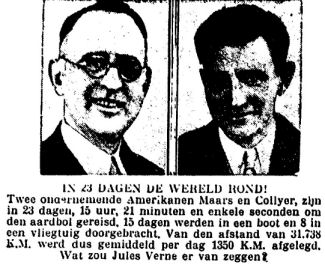
A newspaper reports in 1935 that new air connections will soon enable the trip around the world to be made in a fortnight. A comfortable new type of flying boat is being developed. British aviation policies will henceforth include collaboration with America. Phileas Fogg’s itinerary and progress are listed. The paper comments that we now look upon these with pity and wonders whether our great-grand children will have the same feelings when looking at the achievements of today. (De Courant – Het Nieuws van den Dag, 2 December, 1935).
The following table lists further developments of the record. This is based on the recommended website Round-the-World Flights, where much more detail can be found for those interested.
| Year | Who? | Details | Days | Hours | Minutes | Seconds |
|---|---|---|---|---|---|---|
| 1873 | Verne | fiction | 80 | |||
| 1889 | Nellie Bly | 72 | 6 | 11 | 14 | |
| 1890 | George Train | 67 | 12 | 3 | ||
| 1901 | Fitzmorris | 60 | 13 | 20 | ||
| 1903 | Sayre | 54 | 9 | 42 | ||
| 1908 | Jan Feith | fiction | 40 | |||
| 1913 | Mears | trains, steamships | 36 | 21 | 36 | |
| 1923 | Around the world in 18 days | fiction (film) | 18 | |||
| 1924 | first flight around the world | 371 | 11 | |||
| 1926 | Wells & Evans | 28 | 14 | 36 | 5 | |
| 1927 | Costes & LeBrix | plane, ship | 338 | |||
| 1928 | Mears & Collyer | 23 | 15 | 21 | 3 | |
| 1929 | Graf Zeppelin | 21 | 7 | 34 | ||
| 1931 | Post & Gatty | flight | 8 | 15 | 51 | |
| 1933 | Post | solo flight | 7 | 18 | 49 | 30 |
| 1936 | Ekins | fastest passenger | 18 | 11 | 45 | |
| 1938 | Howard Hughes | 3 | 19 | 14 | 10 | |
| 1939 | Clara Adams | fastest passenger | 16 | 19 | 8 | 10 |
| 1947 | Odom & Sallee | 78 | 55 | 56 | ||
| 1947 | Odom | solo flight | 73 | 5 | 11 | |
| 1949 | Gallagher et al. | non-stop flight | 3 | 22 | 1 | |
| 1957 | Morris et al. | non-stop jet flight | 45 | 19 | ||
| 1962 | John Glenn | Mercury Atlas capsule | 4 | 55 | 23 | |
| 1990 | Concorde | British Airways | 36 | 18 | 57 | |
| 1992 | Concorde | Air France (westward) | 18 | 18 | ||
| 1993 | Concorde | Air France (westward) | 16 | 6 | ||
| 1995 | Concorde | Air France (eastward) | 31 | 27 | 49 | |
| 1997 | Boeing 777 | Malaysian Airline | 41 | 59 | ||
| 1999 | Piccard & Jones | Breitling Orbiter ballon | 19 | 21 | 47 |
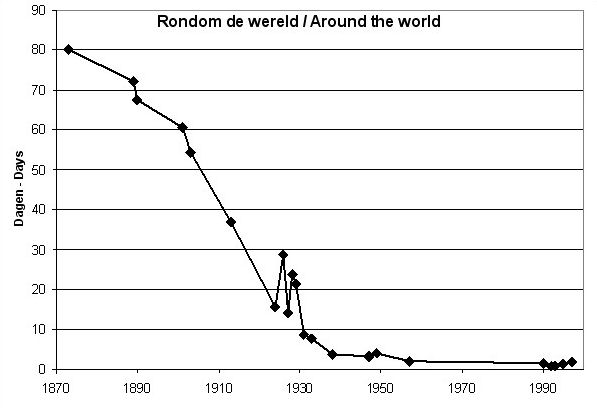
Thanks are due to the National Library of the Netherlands (Koninklijke Bibliotheek) and in particular to its website with digitized historical newspapers entitled Historische kranten in beeld.
